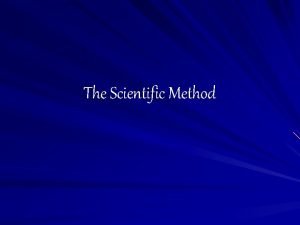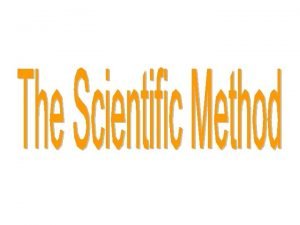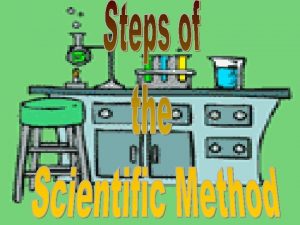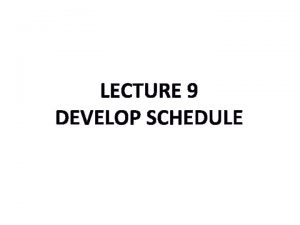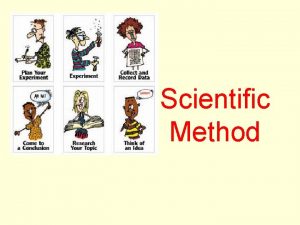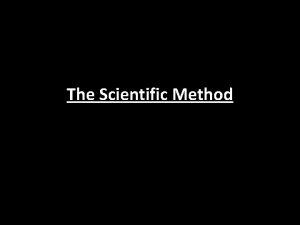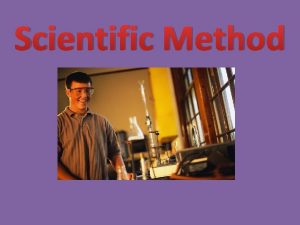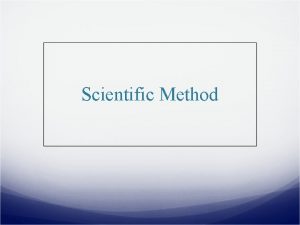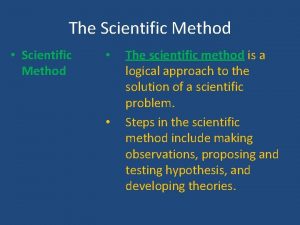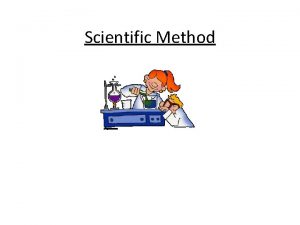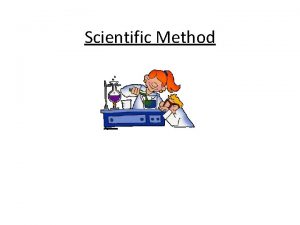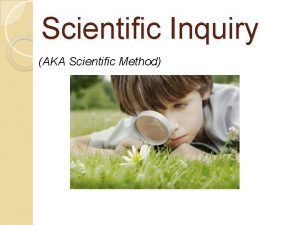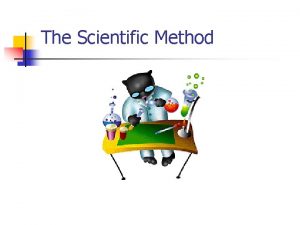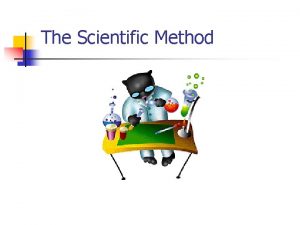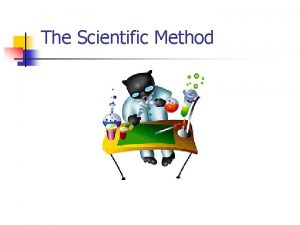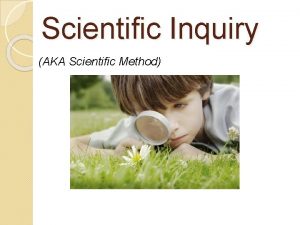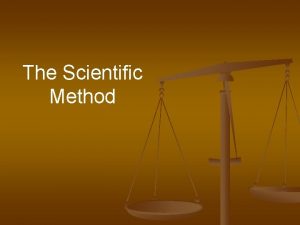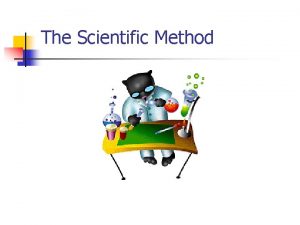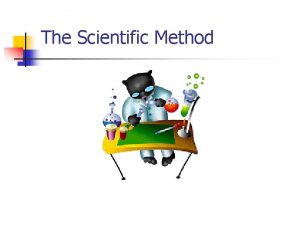The Scientific Method The Scientific Method involves a











































- Slides: 43

The Scientific Method

The Scientific Method involves a series of steps that are used to investigate a natural occurrence.

1. Observation/Research 2. Problem/Question 3. Formulate a Hypothesis 4. Experiment 5. Collect and Analyze Results 6. Conclusion

Steps of the Scientific Method 1. Observation/Research: Make observations and research your topic of interest.

Steps of the Scientific Method 2. Problem/Question: Develop a question or problem that can be solved through experimentation.

Do you remember the next step?

Steps of the Scientific Method 3. Formulate a Hypothesis: Predict a possible answer to the problem or question. Example: If soil temperatures rise, then plant growth will increase.

Steps of the Scientific Method 4. Experiment: Develop and follow a procedure. Include a detailed materials list. The outcome must be measurable (quantifiable).

Steps of the Scientific Method 5. Collect and Analyze Results: Modify the procedure if needed. Confirm the results by retesting. Include tables, graphs, and photographs.

Steps of the Scientific Method 6. Conclusion: Include a statement that accepts or rejects the hypothesis. Make recommendations for further study and possible improvements to the procedure.

Let’s put our knowledge of the Scientific Method to a realistic example that includes some of the terms you’ll be needing to use and understand.

Problem/Question John watches his grandmother bake bread. He ask his grandmother what makes the bread rise. She explains that yeast releases a gas as it feeds on sugar.

Problem/Question John wonders if the amount of sugar used in the recipe will affect the size of the bread loaf?

Observation/Research John researches the areas of baking and fermentation and tries to come up with a way to test his question. He keeps all of his information on this topic in a journal.

John talks with his teacher and she gives him a Experimental Design Diagram to help him set up his investigation.

Formulate a Hypothesis After talking with his teacher and conducting further research, he comes up with a hypothesis. “If more sugar is added, then the bread will rise higher. ”

Hypothesis The hypothesis is an educated guess about the relationship between the independent and dependent variables. Note: These variables will be defined in the next few slides.

Independent Variable The independent, or manipulated variable, is a factor that’s intentionally varied by the experimenter. John is going to use 25 g. , 50 g. , 100 g. , 250 g. , 500 g. of sugar in his experiment.

Dependent Variable The dependent, or responding variable, is the factor that may change as a result of changes made in the independent variable. In this case, it would be the size of the loaf of bread.

Forming a hypothesis A friend notices that her dog is getting thinner even though she has not changed how much she feeds him. Propose 3 testable hypotheses to explain the dog’s weight loss.

Practice Directions: Write a formal hypothesis for each of these statements 1. Cold winters may affect the width 2. 3. 4. 5. of trees Mascara use may lead to pink eye Candy may cause cavities Exercise is related to heart rate Age may be related to risk of a heart attack

Experiment His teacher helps him come up with a procedure and list of needed materials. She discusses with John how to determine the control group.

Control Group In a scientific experiment, the control is the group that serves as the standard of comparison. The control group may be a “no treatment" or an “experimenter selected” group.

Control Group Because his grandmother always used 50 g. of sugar in her recipe, John is going to use that amount in his control group.

Constants John’s teacher reminds him to keep all other factors the same so that any observed changes in the bread can be attributed to the variation in the amount of sugar.

Constants The constants in an experiment are all the factors that the experimenter attempts to keep the same.

Can you think of some constants for this experiment?

Constants They might include: Other ingredients to the bread recipe, oven used, rise time, brand of ingredients, cooking time, type of pan used, air temperature and humidity where the bread was rising, oven temperature, age of the yeast…

Experiment John writes out his procedure for his experiment along with a materials list in his journal. He has both of these checked by his teacher where she checks for any safety concerns.

Trials refer to repeat groups that are exposed to the same conditions in an experiment. John is going to test each sugar variable 3 times.

Collect and Analyze Results John comes up with a table he can use to record his data. John gets all his materials together and carries out his experiment.

Size of Baked Bread (Lx. Wx. H) cm 3 Size of Bread Loaf (cm 3) Trials Amt. of Sugar (g. ) 1 2 3 Average Size (cm 3) 25 768 744 761 758 50 1296 1188 1296 1260 100 1188 1080 1116 250 672 576 588 612 500 432 504 360 432 Control group

Collect and Analyze Results John examines his data and notices that his control worked the best in this experiment, but not significantly better than 100 g. of sugar.

Conclusion John rejects his hypothesis, but decides to re-test using sugar amounts between 50 g. and 100 g.

Experiment Once again, John gathers his materials and carries out his experiment. Here are the results.

Can you tell which group did the best?

Size of Baked Bread (Lx. Wx. H) cm 3 Size of Bread Loaf (cm 3) Trials Amt. of Sugar (g. ) 1 2 3 Average Size (cm 3) 50 1296 1440 1296 1344 60 1404 1296 1440 1380 70 1638 1560 1612 80 1404 1296 1332 90 1080 1200 972 1084 Control group

Conclusion John finds that 70 g. of sugar produces the largest loaf. His hypothesis is accepted.

The Controlled Experiment Control = a standard for comparison Variable = the factor being tested Hypothesis: If I apply more fertilizer, then the tomato plants will produce larger tomatoes. Independent Variable = can be changed or manipulated = fertilizer Dependent Variable = depends on independent variable = tomato size- will respond to experimental treatment

(Shrimp Example) 1. Observation – Those shrimp seem to be the same color as the algae they eat 2. Question – Is shrimp color related to the algae? 3. Hypothesis If algae pigments determine shrimp color then the color of shrimp will change if they eat different algae

4. Experiment to test prediction – Control shrimp eat usual algae, experimental shrimp are fed different algae 5. Results – Did the experimental shrimp develop different colors or not? 6. Conclusion – Food does/does not affect shrimp color Scientific Method Continued

Reject or Accept Original Hypothesis If accepted, you may form a theory and continue to test your theory Theory: hypothesis that has been tested and supported by experimental data – Examples that you have heard before?

Theories Have Limits! Science has no “absolute” truth There is always a possibility that future research or evidence could cause a theory to be revised or thrown out.
 Scientific method involves
Scientific method involves The first step in the scientific method involves
The first step in the scientific method involves The scientific method involves
The scientific method involves Scientific inquiry vs scientific method
Scientific inquiry vs scientific method Size separation is not based on
Size separation is not based on The fast tracking method of schedule compression involves
The fast tracking method of schedule compression involves How is a scientific law different from a scientific theory?
How is a scientific law different from a scientific theory? Hình ảnh bộ gõ cơ thể búng tay
Hình ảnh bộ gõ cơ thể búng tay Lp html
Lp html Bổ thể
Bổ thể Tỉ lệ cơ thể trẻ em
Tỉ lệ cơ thể trẻ em Gấu đi như thế nào
Gấu đi như thế nào Chụp tư thế worms-breton
Chụp tư thế worms-breton Hát lên người ơi
Hát lên người ơi Môn thể thao bắt đầu bằng từ đua
Môn thể thao bắt đầu bằng từ đua Thế nào là hệ số cao nhất
Thế nào là hệ số cao nhất Các châu lục và đại dương trên thế giới
Các châu lục và đại dương trên thế giới Công thức tính độ biến thiên đông lượng
Công thức tính độ biến thiên đông lượng Trời xanh đây là của chúng ta thể thơ
Trời xanh đây là của chúng ta thể thơ Mật thư tọa độ 5x5
Mật thư tọa độ 5x5 Phép trừ bù
Phép trừ bù độ dài liên kết
độ dài liên kết Các châu lục và đại dương trên thế giới
Các châu lục và đại dương trên thế giới Thể thơ truyền thống
Thể thơ truyền thống Quá trình desamine hóa có thể tạo ra
Quá trình desamine hóa có thể tạo ra Một số thể thơ truyền thống
Một số thể thơ truyền thống Cái miệng xinh xinh thế chỉ nói điều hay thôi
Cái miệng xinh xinh thế chỉ nói điều hay thôi Vẽ hình chiếu vuông góc của vật thể sau
Vẽ hình chiếu vuông góc của vật thể sau Thế nào là sự mỏi cơ
Thế nào là sự mỏi cơ đặc điểm cơ thể của người tối cổ
đặc điểm cơ thể của người tối cổ Thế nào là giọng cùng tên
Thế nào là giọng cùng tên Vẽ hình chiếu đứng bằng cạnh của vật thể
Vẽ hình chiếu đứng bằng cạnh của vật thể Phối cảnh
Phối cảnh Thẻ vin
Thẻ vin đại từ thay thế
đại từ thay thế điện thế nghỉ
điện thế nghỉ Tư thế ngồi viết
Tư thế ngồi viết Diễn thế sinh thái là
Diễn thế sinh thái là Dạng đột biến một nhiễm là
Dạng đột biến một nhiễm là Số nguyên là gì
Số nguyên là gì Tư thế ngồi viết
Tư thế ngồi viết Lời thề hippocrates
Lời thề hippocrates Thiếu nhi thế giới liên hoan
Thiếu nhi thế giới liên hoan ưu thế lai là gì
ưu thế lai là gì
